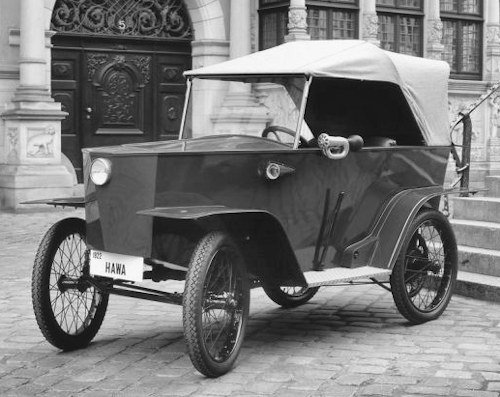Hannoversche Waggonfabrik AG (HAWA)
Automotive manufacturer Hanover - Linden, Germany from 1921 to 1926

HAWA (Hannoversche Waggonfabrik AG) was a German Automotive manufacturer in the 1920s.
History
The Hanover Waggon Factory AG (HAWA) in Hanover - Linden produced from 1898 to 1933 railway cars, tram cars, automobiles, combat aircraft and agricultural machinery.
AG. The company was founded on February 6, 1898 in Linden near Hannover as a Hanoverian woodworking and wagon factories (formerly Max Menzel and Buschbaum & Holland)
The object of the company was the operation of a wagon-building, wagon-building and wood-working factory, in particular for the production and exploitation of all types of railways, tram and other wagons, and the manufacture and sale of all items necessary for the equipment of railway and other means of transport. In 1904 the company name was changed to Hannoversche Waggonfabrik AG and in 1925 to Hannoversche Waggonfabrik AG (Hawa).
The artillery Rademacher Heinrich Christian Oelschläger operated since 1830 in Linden the Rademacher craft. His enterprising son Friedrich Oelschläger received permission in 1857 to manufacture carriage cars. In addition, he made individual parts, such as wheels, drawbars, axles and carried out repair work.
The business was transferred to Wilhelm Buschbaum, who found a partner with the master carpenter Fritz Holland, who provided for an expansion of the construction program and enlargements of the factories. When there was a great need for railway vehicles, the company switched to wagon-building. In 1891 they received the first wagon order for 25 horse trolleys for the Hanover tram. After further tram orders for Braunschweig and Stadthagen followed 1895 the first order over passenger and freight cars for the railway Börßum - Hornburg.
After Max Menzel had secured the financial support of the Hannoversche Bankhaus Ephraim Meyer & Sohn, he joined the company Buschbaum & Holland, and after lengthy negotiations eventually became the public company founded. The foundation fell into a period of stagnation, six wagon factories were founded during the year. Unfavourable terms of payment and depressed prices delayed the recovery despite abundant orders. After the company had managed to obtain significant orders from abroad, mostly for tram cars, which they have in common with the AEG these difficulties were overcome.
The HAWA had a large production range from iron garden pavilions on tractors, threshing machines, electric cars to road and rail cars and aircraft and gliders. From 1921 to 1926, the company produced the Hawa 40 Volt electric compact car in both a passenger car and a van version.
The Hawa 40 Volt electric small car was produced in the first half of the 1920s by the Hanoverian wagon factory (Hawa) in small quantities electric vehicle for road traffic. about 2000 copies of the small Cyclecar, which was powered by a 40-volt battery electric motor The body was made of beech wood covered with plywood. As a passenger car, this was built as a " tandem " two-seater, but also as a small van electric delivery truck Type Em 3 L with a small 0.1 ton payload. The vehicle weighing 320 kg with a wheelbase of 156.4 cm and a track width of 89 cm, the vehicle was 242.3 cm long and 115 cm wide It was distributed by the German automobile factories,(G.D.A) in Berlin until 1926.
